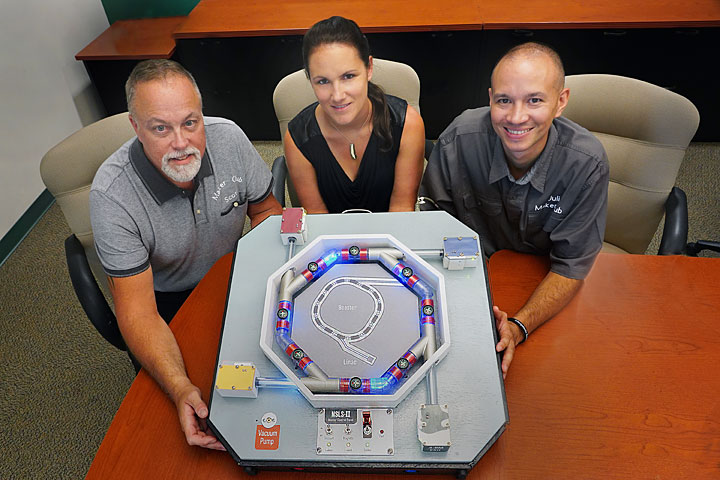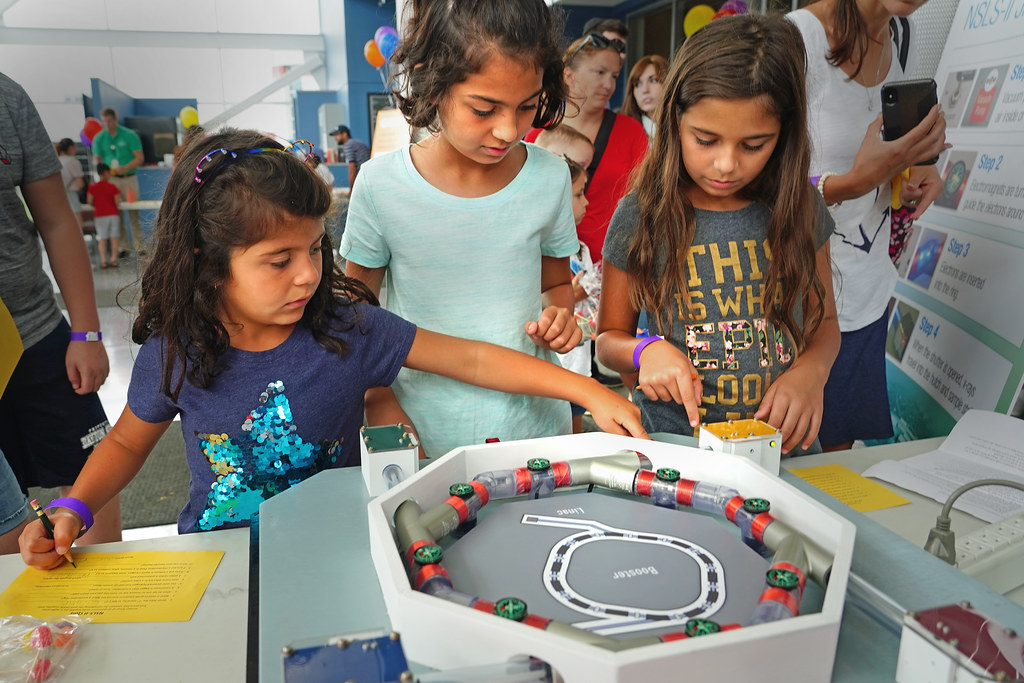Summer Sundays Visitors Become "NSLS-II Junior Operators"
New hands-on model teaches visitors how the National Synchrotron Light Source II works
August 17, 2018
 enlarge
enlarge
From left: Scott Restmeyer of the Collider-Accelerator Department (C-AD), Tiffany Bowman of Creative Resources, and Julio Renta, C-AD. Restmeyer and Renta built a hands-on model of the National Synchrotron Light Source (NSLS-II). Bowman added the final touches to the model by creating the detailed labels for the components. The model will be used at the Lab's Science Learning Center and outreach events to help explain how NSLS-II works.
When Scott Restmeyer and Julio Renta first joined the newly-formed Maker’s Club at the U.S. Department of Energy’s (DOE) Brookhaven National Laboratory, they weren’t totally sure what type of projects they would be working on. But, soon after they joined, along came an exciting request from Kahille Dorsinvil of the Lab’s Stakeholder and Community Relations Office. Dorsinvil asked for help in rebuilding a tabletop model of the National Synchrotron Light Source II (NSLS-II)—a DOE Office of Science User Facility at Brookhaven Lab—that could be used by visitors at Summer Sundays and other outreach events at Brookhaven.
"I was looking to resurrect the old model of NSLS-II to engage our visitors," said Dorsinvil, who coordinates the Summer Sundays program for the Lab. “Having a small, hands-on model of such a complex facility really helps our visitors make sense of the world-class science that goes on at NSLS-II.”
Restmeyer and Renta readily volunteered for the project, knowing it would be a challenge, but they quickly laid out a plan. Renta, a senior technical specialist in Brookhaven’s Collider-Accelerator Department (C-AD), offered the electrical and programming skills while Restmeyer, senior designer in C-AD, provided elite mechanical skills — the perfect combination for this project.
“We examined the existing model, but it was quite worn, so we decided it would be best to build a new one,” said Restmeyer. “To get started, Julio and I met with Cara Laasch and Randy Smith of NSLS-II who gave us a basic understanding on how NSLS-II works. We decided that using 3-D printed materials to design the new model would work best and, from there, Julio and I started building the model.”
What does the model look like and how does it work?
Built on a wooden base, the model includes toggle switches to turn on the vacuum pump, magnets, and beam, plus a shutter button, four hutches with sliding doors, and clear tubing with lights and mounted compasses. The lights will circulate and increase speed to simulate the beam. There are also arcade buttons which send simulated x-rays in to the hutches (when the hutch doors are closed).
“We wanted the model to portray NSLS-II as best we could,” added Renta. “The challenge was to make it work only if you followed the right sequence. So, you wouldn’t get ‘beam’ if you didn’t close the door of the hutch and open the shutter. We even included a red light and error alarm if the ‘operator’ didn’t follow the proper sequence.”
The model sequence goes like this:
- “Operators” first start the vacuum pumps by flipping a switch. Electrons at NSLS-II cannot travel through air, so it is important that the vacuum pumps get switched on.
- Next, the “operator” needs to hit a switch to turn on the magnets. At NSLS-II, magnets ensure the electrons follow a steady path and can turn the corners in the storage ring, where they will eventually emit ultrabright x-rays.
- The “operator” can let the electron beam into the ring where it will circle around.
- In the final step, the “operator” closes the experimental hutch and opens the shutter to let the ultrabright x-rays into the hutch so that they can interact with scientific samples.
The model intricately labels all these steps and Summer Sundays visitors were thrilled when they were successful in getting the x-rays into the experimental hutch.
Tiffany Bowman, a graphic designer in the Lab’s production services division, added the final touches to the model by creating labels for NSLS-II’s control panel, booster and linac, beamline hutches, and vacuum pump. Bowman also created the poster that describes how to operate the model and what is happening when a switch is flipped, or a button is pushed.
“We are happy with how the model turned out,” said Renta. “Cyrus Biscardi of C-AD helped machine the hutches using a drawing made by Scott. It really was a collaborative effort.”
“I thoroughly enjoyed this project,” said Restmeyer. “I don’t have much experience with woodworking, so this was a new challenge for me. I learned a lot and I’m happy that the model was a success at Summer Sundays and will now be used at the Lab’s Science Learning Center and other outreach venues where kids can learn hands-on how NSLS-II works.”
"When Scott and Julio offered to build a new model, I wasn't sure what to expect, but they did a fantastic job,” said Dorsinvil. “The visitors loved it!”
New projects
Renta and Restmeyer are already looking for a new project. Do you have any ideas? If so, come to a Maker’s Club meeting.
We would welcome new members to the Maker’s Club,” Restmeyer added. “We meet in Berkner every Friday during lunch to discuss new projects, share ideas, and mentor each other. Everyone brings a different expertise to the table and it is interesting and quite amazing to see what people are capable of constructing.”
For more information about the club, contact William Jackson, Ext. 7139, wjackson@bnl.gov .
Brookhaven National Laboratory is supported by the Office of Science of the U.S. Department of Energy. The Office of Science is the single largest supporter of basic research in the physical sciences in the United States, and is working to address some of the most pressing challenges of our time. For more information, please visit science.energy.gov.
Follow @BrookhavenLab on Twitter or find us on Facebook.
2018-13041 | INT/EXT | Newsroom










